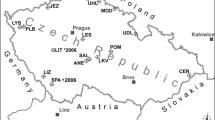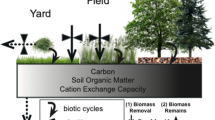Abstract
The Covered Catchment Experiment at Gårdsjön is a large scale forest ecosystem manipulation, where acid precipitation was intercepted by a 7000 m2 plastic roof and replaced by `clean precipitation' sprinkled below the roof for ten years between 1991 and 2001. The treatment resulted in a strong positive response of runoff quality. The runoff sulphate, inorganic aluminium and base cations decreased, while there was a strong increase in runoff ANC and a moderate increase in pH. The runoff continued to improve over the whole duration of the experiment. The achieved quality was, however, after ten years still considerably worse than estimated pre-industrial runoff at the site. Stable isotopes of sulphur were analysed to study the soil sulphur cycling. At the initial years of the experiment, the desorption of SO4 from the mineral soil appeared to control the runoff SO4 concentration. However, as the experiment proceeded, there was growing evidence that net mineralisation of soil organic sulphur in the humus layer was an additional source of SO4 in runoff. This might provide a challenge to current acidification models. The experiment convincingly demonstrated on a catchment scale, that reduction in acid deposition causes an immediate improvement of surface water quality even at heavily acidified sites. The improvement of the runoff appeared to be largely a result of cation exchange processes in the soil due to decreasing concentrations of the soil solution, while any potential change in soil base saturation seemed to be less important for the runoff chemistry over the short time period of one decade. These findings should be considered when interpreting and extrapolating regional trends in surface water chemistry to the terrestrial parts of ecosystems.
Similar content being viewed by others
References
Allott, T. E. H., Harriman, R. and Battarbee, R. W. : 1992, ‘Reversibility of lake acidification at the Round Loch of Glenhead, Galloway, Scotland', Environ. Pollut. 77(2—3), 219—225.
Andersson, B. I., Bishop, K. H., Borg, G. C., Giesler, R., Hultberg, H., Huse, M., Moldan, F., Nyberg, L., Nygaard, P. H. and Nystrom, U. : 1998, ‘The Covered Catchment Site: A Description of the Physiography, Climate and Vegetation of Three Small Coniferous Forest Catchments at Gardsjon, South-west Sweden’, in H. Hultberg and R. Skeffington (eds), Experimental Reversal of Rain Effects: Gardsjon Roof Project, John Wiley & Sons Ltd., Chichester, England, pp. 25—70.
Andersson, F. and Olsson, B. : 1985, ‘Lake Gårdsjön, An Acid Forest Lake and its Catchment’, Ecological Bulletins 37, AiO Print Ltd, Odense, Denmark, pp. 336.
Bernes, C. : 1993, Nordens miljö — tillstånd, utveckling och hot. (Nordic environment — state, development and threat), Monitor 13, Statens Naturvårdsverk, Solna, pp. 211.
Bishop, K. H. and Hultberg, H. : 1995, ‘Reversing acidification in a forest ecosystem-The Gårdsjön covered catchment’, Ambio 24(2), 85—91.
Driscoll, C. T. : 1984, ‘A Procedure for the fractionation of aqueous aluminum in dilute acidic waters’, Int. J. Environ. Anal. Chem. 16, 267—284.
EMEP/MSC-W: 1998, Transboundary Acidifying Air Pollution in Europe, Part 1: EMEP/MSCW 1/98, ISSN 0332-9879, DNMI Research Report 66, p. 150.
Evans, C. D., Cullen, J. M., Alewell, C., Kopácek, J., Marchetto, A., Moldan, F., Prechtel, A., Rogora, M., Veselý, J. and Wright, R. F. : 2001, ‘Recovery from acidification in European surface waters’, Hydrol. Earth Syst. Sci. 5(3), 283—298.
Gaines, G. L. and Thomas, H. C. : 1953, ‘Adsorption studies on clay minerals: II. A formulation of the thermodynamics of exchange adsorption’, J. Chem. Phys. 21, 714—718.
Giesler, R., Moldan, F., Lundström, U. and Hultberg, H. : 1996, ‘Reversing acidification in a forested catchment in southwestern Sweden: Effecs on soil solution chemistry’, J. Environ. Qual. 25, 110—119.
Gilbert, R. O. : 1987, Statistical Methods for Environmental Pollution Monitoring, John Wiley & Sons Ltd., New York, pp. 320.
Gustafsson, J. P. : 1995, ‘Modelling pH-dependent sulfate adsorption in the Bs horizons of podzolized soils’, J. Environ. Qual. 24, 882—888.
Gustafsson, J. P., Van Hees, P., Starr, M., Karltun, E. and Lundström, U. : 2000, ‘Partitioning of base cations and sulphate between solid and dissolved phases in three podzolised forest soils’, Geoderma 94(2—4), 311—333.
Hultberg, H. and Skeffington, R. : 1998, Experimental Reversal of Rain Effects: Gardsjon Roof Project, John Wiley & Sons Ltd., Chichester, England, pp. 466.
Jenkins, A., Helliwell, R. C., Swingewood, P. J., Sefton, C., Renshaw, M. and Ferrier, R. C. : 1998, ‘Will reduced sulphur emissions under the Second Sulphur Protocol lead to recovery of acid sensitive sites in U. K. ?’, Environ. Pollut. 99(3), 309—318.
Krouse, H. R. and Grinenko, V. A. : 1991, Stable Isotopes Natural and Anthropogenic Sulphur in the Environment, Scope 43, John Wiley & Sons Ltd., Chichester.
Matschonat, G. and Vogt, R. : 1997, ‘Effects of changes in pH, ionic strength, and sulphate concentration on the CEC of temperate acid forest soils’, European J. Soil Sci. 48(1), 163—171.
Matschonat, G. and Vogt, R. : 1998, ‘Significance of the total cation concentration in acid forest soils for the solution composition and the saturation of exchange sites’, Geoderma 84(4), 289—307.
Moldan, F., Hultberg, H. and Andersson, I. : 1995, ‘Covered catchment experiment at Gårdsjön: Changes in runoff chemistry after four years of experimentally reduced acid deposition’, Water, Air, Soil Pollut. 85(3), 1599—1604.
Moldan, F., Andersson, I., Bishop, K. H. and Hultberg, H. : 1998, ‘Catchment-scale Acidification Reversal Experiment at Gårdsjön, South-west Sweden: Assessment of the Experimental Design’, in H. Hultberg and R. Skeffington (eds), Experimental Reversal of Acid Rain Effects: The Gårdsjön Roof Project, Wiley & Sons, pp. 85—108.
Moldan, F., Wright, R. F., Lövgren, S., Forsius, M., Ruoho-Airola, T. and Skjelkvåle, B. L. : 2001, ‘Long-term Changes in Acidification and Recovery at Nine Calibrated Catchments in Norway, Sweden and Finland', in J. S. G. McCulloch, A. Jenkins, R. C. Ferrier and R. F. Wright (eds), Hydrology and Earth System Sciences, Vol. 5(3), European Geophysical Society, Germany, pp. 339—349.
Mörth, C. -M. : 1995, ‘Sulphur Isotopes used as a Tracer of Acidification Reversal, Dispersion of Acid Mine Drainage and Sulphur Dynamics in Small and Large Catchments’, Meddelanden från Stockholms Universitets institution för Geologi och Geokemi, No. 290, Ph. D. Thesis, Department of Geology and Geochemistry, Stockholm University, pp. 26.
Mörth, C. -M. and Torssander, P. : 1995, ‘Sulfur and oxygen isotope ratios in sulfate during an acidification reversal study at Lake Gardsjon, western Sweden’, Water, Air, Soil Pollut. 79(1—4), 261—278.
Mörth, C. -M., Giesler, R., Torssander, P., Stuanes, A., Kjønaas, O. J. and Moldan, F. : ‘Changes in sulphate pools and ? 34S after experimental exclusion of anthropogenic deposition’, Environ. Sci. Tech., p. 25 (submitted).
Newell, A. D. and Skjelkvåle, B. L. : 1997, ‘Acidification trends in surface waters in the international program on acidification of rivers and lakes’, Water, Air, Soil Pollut. 93(1—4), 27—57.
Novák, M., Bottrell, S. H., Fottová, D., Buzek, F., Groscheová, H. and Zak, K. : 1996, ‘Sulfur isotope signals in forest soils of Central Europe along an air pollution gradient’, Environ. Sci. Tech. 30(12), 3473—3476.
Reuss, J. O. : 1983, ‘Implications of the calcium-aluminium exchange system for the effect of acid precipitation on soils’, J. Environ. Qual. 12(4), 591—595.
Reuss, J. O. and Johnson D. W. : 1986, ‘Acid Deposition and the Acidification of Soils and Waters’, Ecological Studies 59, Springer-Verlag, New York, pp. 119.
Sefton, C. and Jenkins, A. : 1998, ‘A regional application of the MAGIC model inWales: Calibration and assessment of future recovery using a Monte-Carlo approach’, Hydrol. Earth Syst. Changes 2(4), 521—531.
Skjelkvåle, B., Wright, R. and Henriksen, A. : 1998, ‘Norwegian lakes show widespread recovery from acidification; Results from national surveys of lakewater chemistry 1986—1997’, Hydrol. Earth Syst. Sci. 2(4), 555—62.
Skjelkvåle, B. L., Mannio, J., Wilander, A. and Anderson, T. : 2001, ‘Recovery from acidification of lakes in Finland, Norway and Sweden 1990—1999’, Hydrol. Earth Syst. Sci. 5(3), 327—337.
Stoddard, J. L., Driscoll, C. T., Kahl, J. S. and Kellogg, J. P. : 1998, ‘Can site-specific trends be extrapolated to a region? An acidification example for the northeast’, Ecol. Appl. 8(2), 288—99.
Sverdrup, H. U., Warfvinge, P., Hultberg, H., Andersson B. I. and Moldan, F. : 1998, ’ Modelling Soil Acidification and Recovery in a Roofed Catchment: Application of the SAFE Model’, in H. Hultberg and R. Skeffington (eds), Experimental Reversal of Acid Rain Effects: The Gårdsjön Roof Project, Wiley & Sons, pp. 363—382.
Torssander, P. and Mörth, C. -M. : 1998, ‘Sulfur Dynamics in the Roof Experiment at Lake Gårdsjön Deduced from Sulfur and Oxygen Isotope Ratios in Sulfate’, in H. Hultberg and R. Skeffington (eds) Experimental Reversal of Acid Rain Effects: The Gårdsjön Roof Project, Wiley & Sons, pp. 185—206.
Van Stempvoort, D. R., Reardon, E. J. and Fritz, P., 1990, ‘Fractionation of sulfur and oxygen isotopes in sulfate by soil sorption’, Geochem. Cosmochim. Acta 54, 2817—2826.
Wesselink, L. G., Meiwes, K. J., Matzner, E. and Stein, A. : 1995, ‘Long term changes in water and soil chemistry in spruce and beech forests, Solling, Germany’, Environ. Sci. Technol. 29(1), 51—58.
Wilander, A. : 1997, ‘Referenssjöarnas vattenkemi under 12 år; tillstånd och trender’, Naturvårdsverket Rapport 4562, Statens Naturvårdsverk, Stockholm, pp. 79.
Wright, R. F., Cosby, B. J., Ferrier, R. C., Jenkins, A., Bulger, A. J. and Harriman, R. : 1994, ‘Changes in acidification of lochs in Galloway, Southwestern Scotland, 1979—1988 — The magic model used to evaluate the role of afforestation, calculate critical loads, and predict fish status’, J. Hydrology 161(1—4), 257—285.
Author information
Authors and Affiliations
Corresponding author
Rights and permissions
About this article
Cite this article
Moldan, F., Skeffington, R.A., Mörth, CM. et al. Results from the Covered Catchment Experiment at Gårdsjön, Sweden, after Ten Years of Clean Precipitation Treatment. Water, Air, & Soil Pollution 154, 371–384 (2004). https://doi.org/10.1023/B:WATE.0000022968.28717.61
Issue Date:
DOI: https://doi.org/10.1023/B:WATE.0000022968.28717.61




